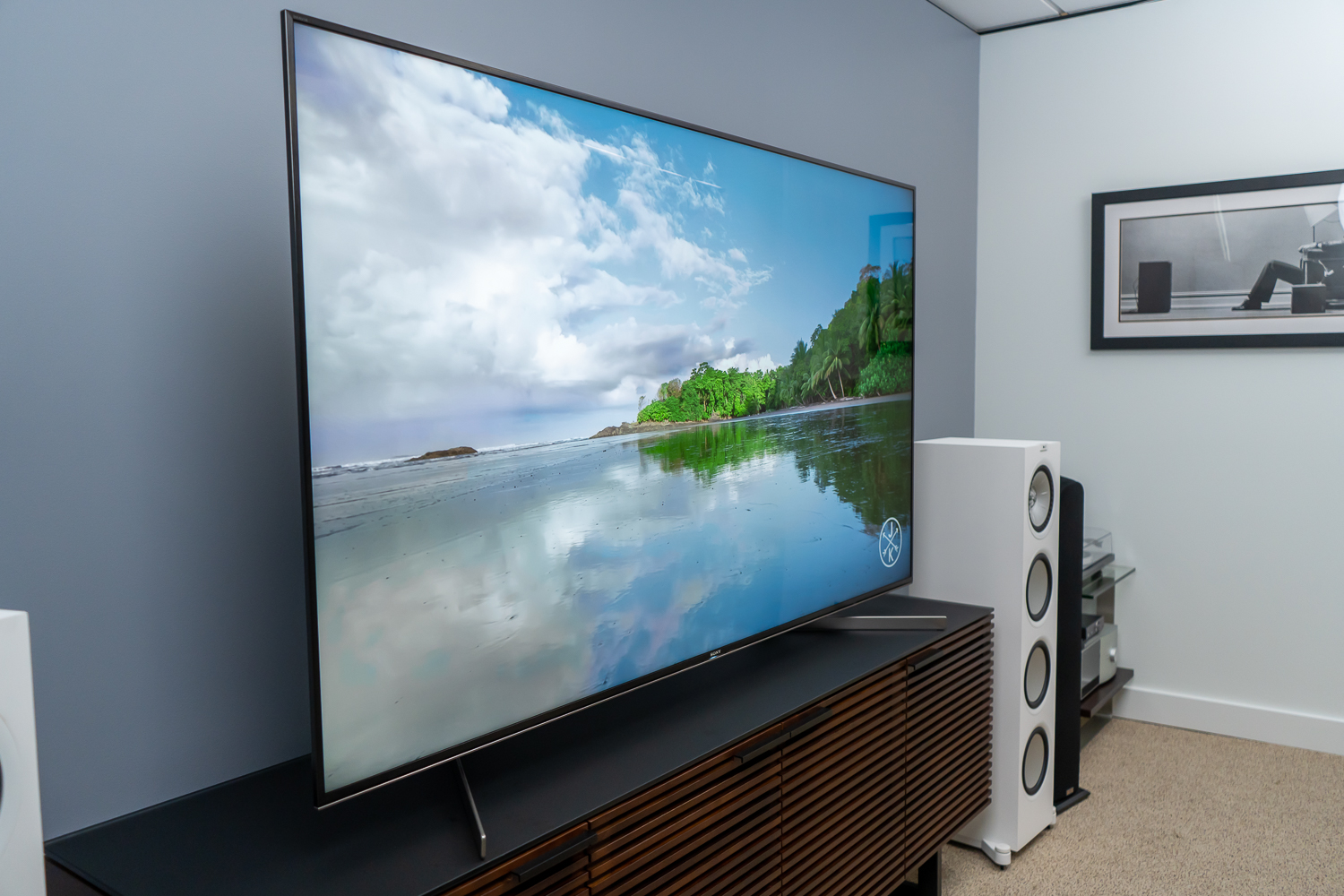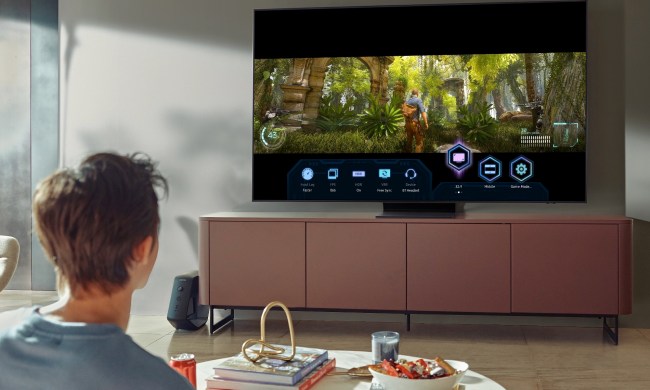- Beautiful Color
- Excellent HDR highlight detail
- Respectable black levels
- Excellent motion
- Reduced blooming
- Unimpressive sound
- X-Wide Angle only in large sizes
There’s plenty to talk about here, but just in case you’re in a rush, here’s the bottom line. The Sony X950G is an outstanding LED TV, especially worthy of consideration if technically accurate picture quality is of paramount concern.
What’s more, the X950G is a bit more attainable than its OLED cousins, the Sony A9G and A8G, bringing Sony’s outstanding picture processing to more home theater rooms and living rooms.
Wanna join the club?
Increasingly, Sony’s TVs are aimed toward the homes of a very dedicated, enthusiastic, and well-informed fan base. Several years ago, Sony decided to go premium with its home entertainment division. It may not make as many models as its popular South Korean competitors, Samsung and LG, but it can rightly claim that the few TVs it does make are all really, really good. Some are downright excellent — the Sony A9G OLED is our pick for TV of the year.
With that in mind, you might think the Sony X950G appeals to a small audience. And perhaps it does. But it shouldn’t. It’s a lovely television, and fourth in line behind my top three picks this year (in terms of picture quality), the Sony A9G OLED, the LG C9 OLED, and the Samsung Q90R. If you’re in the top five, you’re doing just fine.
Looking the part
The Sony X950G series will set you back a few bucks no matter which size you pick. Current pricing for the 55-inch ($1100), 65-inch ($1600), 75-inch ($2500), and 85-inch ($4,000), are all on the high side for 2019, but Sony is betting that its legendary picture processing will be worth it for those who want the most cinematic-looking TV they can get.

Wrapped around that picture processing (discussed in detail below), you’ll get an attractive TV. The X950G is adorned with trim bezels, high-quality metal accents, and a slim-enough profile considering its a TV with a space-hogging full-array local dimming backlight system.
Even the remote control gets an upgrade this year as Sony transitioned to the plastic remote its used for decades and finally stepped up to a metal casing. The remote’s layout is simplified a bit, too, though it isn’t as minimalist as Samsung’s One Remote design.
My only gripe about the X950G’s design is the stand. While its stout metal construction is stable, it’s also got a seriously wide span. The 75-inch model I tested came in at 56 inches, which is far wider than many popular entertainment stands. We’re lucky to have the BDI Corridor Media Center in our testing lab, but those with smaller entertainment cabinets may want to plan to wall-mount the TV rather than spring for a new piece of furniture and a possible room rearrangement.
Ultimate processing
It couldn’t be a Sony TV review without a discussion about Sony’s lauded picture processing, right? After all, it’s the picture processing that literally makes the difference between Sony’s A9G OLED and LG’s C9 OLED (or E9, or W9). Sony uses LG OLED panels, but it’s Sony’s processing that makes the A9G look like a Sony, and that same processor, the X1 Ultimate, is at the heart of the Sony X950G as well.
How does picture processing make such a difference? Consider a PC for a moment. To see great graphics on a computer, you need a powerful graphics card. You can get by with the graphics processor included with a computer’s CPU if you’re just browsing the web and reading an email, but if you want to play a game, you’d better have some horsepower on hand.
A TV is more similar than you’d think. It needs significant processing power to analyze images in real-time and digitally upscale their resolution, optimize HDR performance, get color saturation right and, in the case of an LED/LCD TV like the X950G, get the LED backlight system to do its job well.
(Under)Powered for Android
Unfortunately, while the picture processing engine is very powerful, the separate chip that runs the Android TV platform is inadequate. Sony does have a more advanced chip that runs Android TV well — it’s in the Master Series A9G OLED — but you won’t find it in the step-down A8G OLED, nor will you find it here.
Unfortunately, this results in a sluggish, buggy experience when navigating TV menus or scrolling through apps and content. To be fair, this isn’t Sony’s fault — Android TV is notoriously resource-intensive — but if you’re going to hitch your wagon to Android TV, it would be best to make sure it runs well in one of your best TVs, no? To be clear, the processor that runs Android TV has nothing to do with picture processing, only with the smart TV platform.
With all of that put out there, I do think it’s worth pointing out that the X950G runs Android TV better than Sony TVs produced even as recently as last year. They are getting better.
That picture, though!
Before I jump into how good the X950G’s picture quality is, let me point out a pretty serious variable in performance. The 55- and 65-inch versions of this TV do not come with Sony’s new X-Wide Angle technology. That tech is reserved for the big 75- and 85-inch versions.
Without getting too deep into the weeds, X-Wide Angle is a panel layer which promises to retain color saturation and contrast when the TV is viewed from the far sides or well above or below the TV. This is an issue I gripe about all the time in my TV reviews, because I know a lot of folks who sit off to the side on a sectional couch, and they definitely don’t end up getting the best seat in the house.

Sony’s X-Wide Angle filter makes the blacks look a little grey. However, in the trade-off between better off-angle viewing and a slight hit to the black levels, I’ll take the better off-angle viewing. If you have read similar things about IPS panels, know this. The blacks I saw on the 75-inch X950G with X-Wide Angle were better than what I’ve seen with most IPS panels. So, make your choice as you will.
If you don’t want the X-Wide Angle, then get the 65-inch TV, and if you do, you’ll need to pony up another $900 and get the 75-inch bad-boy.
As for overall performance, the X950G is great. Other TVs get a little brighter, some have better black levels, others still have more aggressive HDR brightness, but when it comes to color accuracy and a cinematic, accurate presentation, the X950G, right out of the box, is tough to beat.
One of the things I appreciated most was the X950G’s preservation of highlight detail. I watch a lot of HDR content and tire easily of blown-out images, but the X950G manages to deliver sparkle and pizazz without being too aggressive and sacrificing detail that content makers want you to see.
Everything I watched, from Blu-ray movies to sports on crappy, compressed cable TV, looked its best. The X950G is an especially good upscaler, so no matter what signal you feed the TV, the image looks better by the time you see it than when the TV got a hold of it. The X950G motion handling is, in my estimation, the best out there, so you won’t have to deal with judder or blur, and you won’t have to deal with any soap opera effect, either.
When it all comes together, the X950G looks extremely natural. That’s the real magic of Sony’s X1 Ultimate processor.
Good for gamers?
If you are a serious gamer and want the best display to keep you competitive, this X950G may not be your best choice. This TV doesn’t offer auto low-latency mode, variable refresh rate, or any other HDMI 2.1 features other than eARC. For those forward-looking features, you might want to look at a high-end LG TV instead.
But how’s the sound?
Simply put: I think you’ll want to get a soundbar for use with this television. The on-board audio has been enhanced with a couple of speakers located at the top of the TV for assistance with sound position (an approximation of the screen-based sound found on Sony’s OLED TVs) but I found the sound a bit thin. It could use some “oomph,” and for that, a soundbar is called for.
Our Take
Sony’s X950G is a beautiful, cinematic TV. What it lacks in brightness intensity, it makes up for in preservation of highlight detail. This look may not be as dazzling at the outset, but when paired with great color and respectable black levels, the result is a refined image that exudes class and finesse.
Is there a better alternative?
For a brighter, more intense TV, the Samsung Q90R would be a solid choice. For better black levels, screen uniformity, off-angle viewing, and the latest gaming-friendly features, the LG C9 OLED is a more compelling, albeit more expensive, option.
How long will it last?
As is true for the Sony A9G OLED, the Sony X950G should last a long time thanks to Sony’s excellent track record of build quality. As far as future-proofing goes, I’d like to see the same full-spec HDMI 2.1 ports that LG offers on its 2019 OLED TVs, but considering there’s no practical use for HDMI 2.1 just yet, I’m not going to dock Sony for that.
Warranty
Sony offers a one-year warranty, provided you purchase the TV from an authorized dealer.
Should you buy it?
Yes. If you prefer finesse over flash, the X950G is a top-notch LED/LCD TV. All other considerations being equal, nobody beats Sony for a studio-quality TV.





